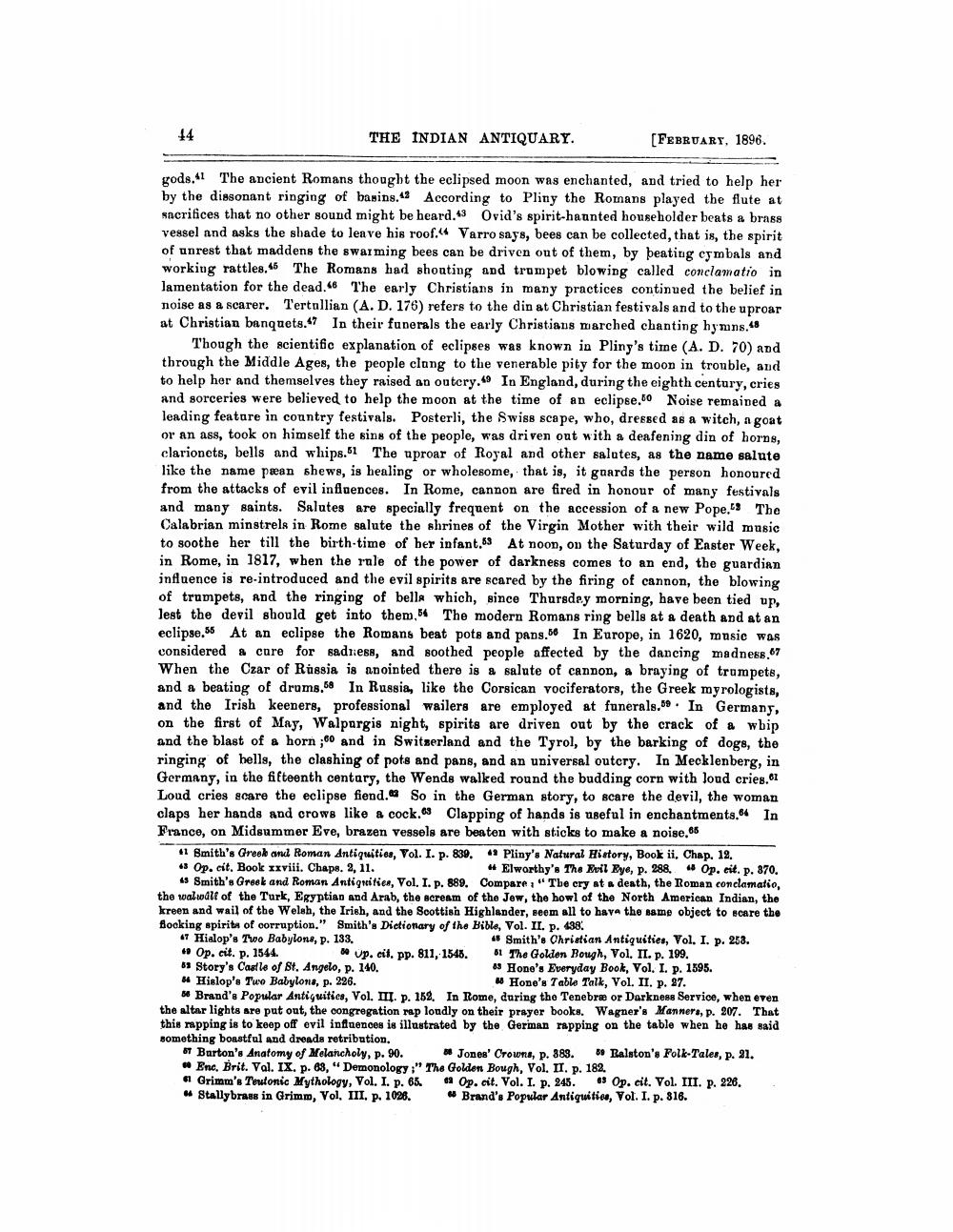________________
THE INDIAN ANTIQUARY.
(FEBRUART, 1896.
gods. The ancient Romans thought the eclipsed moon was enchanted, and tried to help her by the dissonant ringing of basins. According to Pliny the Romans played the flute at sacrifices that no other sound might be heard.43 Ovid's spirit-haunted house holder beats a brass vessel and asks the shade to leave his roof. Varro says, bees can be collected, that is, the spirit of unrest that maddens the swarming bees can be driven out of them, by beating cymbals and working rattles. The Romans had shouting and trumpet blowing called conclamatio in lamentation for the dead. The early Christians in many practices continued the belief in noise as a scarer. Tertullian (A. D. 176) refers to the din at Christian festivals and to the uproar at Christian banquets. In their funerals the early Christians marched chanting hymns. 48
Though the scientific explanation of eclipses was known in Pliny's time (A. D. 70) and through the Middle Ages, the people clong to the venerable pity for the moon in trouble, and to help her and themselves they raised an outcry.49 In England, during the eighth century, cries and sorceries were believed to help the moon at the time of an eclipse.50 Noise remained a leading feature in country festivals. Posterli, the Swiss scape, who, dressed as a witch, a goat or an ass, took on himself the sins of the people, was driven out with a deafening din of horns, clarionets, bells and whips.51 The uproar of Royal and other salutes, as the name salute like the name pæan shewe, is healing or wholesome, that is, it gaards the person honoured from the attacks of evil influences. In Rome, cannon are fired in honour of many festivals and many saints. Salutes are specially frequent on the accession of a new Pope. The Calabrian minstrels in Rome salute the shrines of the Virgin Mother with their wild music to soothe her till the birth-time of her infant.53 At noon, on the Saturday of Easter Week, in Rome, in 1817, when the role of the power of darkness comes to an end, the guardian influence is re-introduced and the evil spirits are scared by the firing of cannon, the blowing of trumpets, and the ringing of bells which, since Thursdey morning, have been tied up, Jest the devil should get into them. The modern Romans ring bells at a death and at an eclipse.56 At an eclipse the Romans beat pots and pans. In Europe, in 1620, music was considered a cure for sadress, and soothed people affected by the dancing madness.67 When the Czar of Russia is anointed there is a salute of cannon, a braying of trumpets, and a beating of drums.58 In Russia, like the Corsican vociferators, the Greek myrologists, and the Irish keeners, professional wailers are employed at funerals.. In Germany, on the first of May, Walpargis night, spirits are driven out by the crack of a wbip and the blast of a horn ;60 and in Switserland and the Tyrol, by the barking of dogs, the ringing of hells, the clashing of pots and pans, and an universal outcry. In Mecklenberg, in Germany, in the fifteenth centary, the Wends walked round the budding corn with loud cries.cz Loud cries scare the eclipse fiend. So in the German story, to scare the devil, the woman claps her hands and crows like a cock. Clapping of hands is useful in enchantments. In France, on Midsummer Eve, brazen vessels are beaten with sticks to make a noise.65
41 Smith's Greek anul Roman Antiquities, Vol. I. p. 839. ^ Pliny's Natural History, Book ii, Chap. 12. • Op. cit. Book xxviii. Chaps. 2, 11.
- Elworthy's The Weil Eye, p. 288. 4 Op. cit. p. 870. Smith's Greek and Roman Antigreities, Vol. I. p. 889. Compare , "The cry at a death, the Roman conclamatio, the saludut of the Turk, Egyptian and Arab, the scream of the Jew, the howl of the North American Indian, the kreen and wail of the Welsh, the Irish, and the Scottish Highlander, seem all to have the same object to scare the flocking spirits of corruption." Smith's Dictionary of the Bible, Vol. II. p. 438. 7 Hislop's Two Babylons, p. 133.
45 Smith's Christian Antiquities, Vol. I. p. 253. + Op. cit. p. 1544.
up. cit. pp. 811, 1548. 61 The Golden Bough, Vol. II. p. 199. 53 Story's Castle of St. Angelo, p. 140.
* Hone's Everyday Book, Vol. I. p. 1595. # Hislop's Two Babylons, p. 226.
Hone's Table Talk, Vol. II. p. 27. * Brand's Popular Antiquities, Vol. . p. 152. In Rome, during the Tenebræ or Darkness Service, when even the altar lights are put out, the congregation map loudly on their prayer books. Wagner's Manners, p. 207. That this mapping is to keep off evil influences is illustrated by the German rapping on the table when he has said something boastful and dreads retribution, 57 Burton's Anatomy of Melancholy, p. 90. Jones' Crowna, p. 389. Ralston's Folk-Tales, p. 21.
Enc. Brit. Val. IX. p. 63,"Demonology:" The Golden Bough, Vol. II. p. 182. Grimm's Teutonic Mythology, Vol. I. p. 65. Op.cit. Vol. I. p. 245. " Op. cit. Vol. III. p. 226. Stally brass in Grimm, Vol. III. p. 1026. Brand's Popular Antiquities, Vol. I. p. 316.




